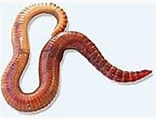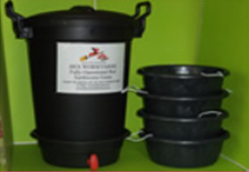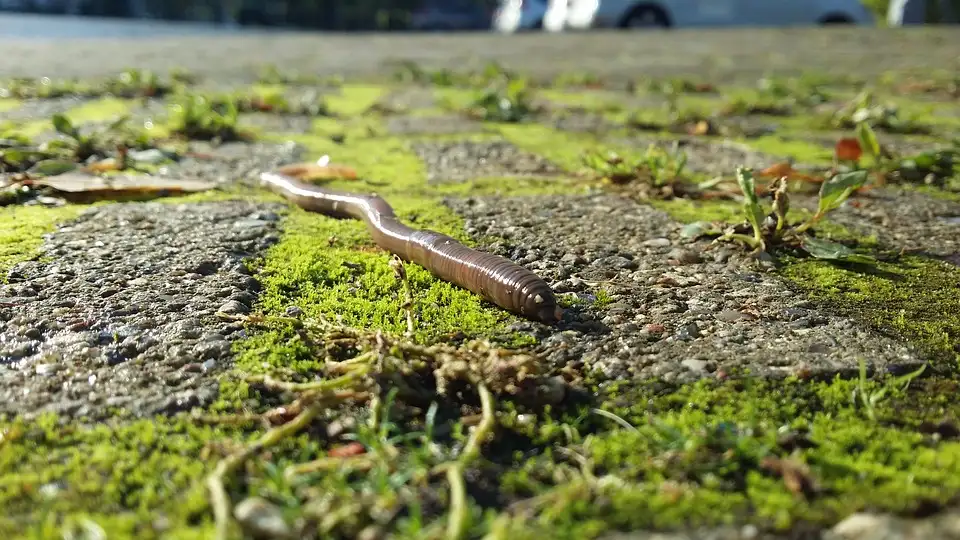Vermiculture
Agriculture is defined as the cultivation of the soil for the growing of crops and the rearing of animals. Horticulture is the cultivation and management of gardens. Vermiculture is the cultivation of earthworms – especially to use them to convert organic waste into fertilizer.
Most people with big gardens are probably already familiar with the small squiggly mounds of mud you find in your lawn after the earthworms have been at work: once the mud dries, they are quite painful to tread on with bare feet. But these worm castings are very nutritious for plants. They have a high nitrogen content, and are also rich in proteins, minerals, your household, you will also have a never-ending supply of worm castings. What is more, the liquid that leaks out of the basins of castings can be used both as a liquid fertilizer and as a natural pesticide.
I had a worm farm, several years ago, which I got from Hex Worm Farms in the Durban area, KZN (South Africa). This article is mainly based on the information booklet that came with my worms, which were red saddle backs (Eisenia fetida) –

[picture credit: Wikipedia]
– but presumably different countries and climates have slightly different varieties that work best for them. Accordingly, the information in this article should be used as a general guide only, and may not be applicable to all worm farms everywhere.
Setting Up
This is what my wormery from Hex looked like (see below): a bottom bowl with tap, a large bin, and four round basins that fit one on top of the other inside the bin. The four basins are not solid, but have a kind of mesh for their bottoms, so that liquid can easily drain out. When your farm is up and running, you will add vegetable matter to the basins every week, which the worms will consume and convert into castings. The liquid created in the process will collect at the bottom of the bin, and you will be able to pour it out through the tap.

[picture credit: Hex worm farms]
To set up this kind of a worm farm, here is the process:
On the floor, place the basin with the tap, standing slightly off the ground (use four bricks on their sides, or something of similar height). Use the 2l of worm tea provided to fill this basin (up to the bottom edge of the hole for the tap). Then put the bin into this bottom basin. For outside worm farms, tape a wide strip of plastic onto the bin, above the edge of the basin, so that any rain runs off the plastic without getting into the bottom basin (rain in the basin would dilute the worm tea to the point that it was ineffectual).
Then take the first of the other bowls and line it with newspaper (the absorbent kind, not the glossy kind). Use something small, like coke bottle lids, on the bottom of the bin, just to keep the bottom of this first bowl slightly raised off it. Put a small helping of food in the middle, and tip the worms onto the food.
A bin-sized worm farm can be placed outdoors, in a garage or shed, on a balcony or verandah, or even in the house – the bins are not very large, and completely odorless. Pretty much the only restriction is that you need to protect your worms from extreme temperatures. At the absolute outside, worms can handle temperatures between about 5°C and 37°C (41-98.6°F), but they prefer moderate temperatures, so try not to let them get into the extreme ends of this spectrum.
Feeding
At first, about half a cup of mixed and shredded organic materials once a week should be enough.
In much the same way I said you need to add a good balance of soft and/or wet, and hard and/or dry, material to your compost heap, you need to feed your worms a mix of ‘greens’ and ‘browns.’ Having a good green vs. brown balance helps with the aeration of the bin contents, and also provides the composting microbes with a good nutritional balance.
The greens don’t have to be literally green in color, but they are anything soft and juicy. Greens tend to have a high nitrogen content, and nitrogen is a critical element in proteins and amino acids – so feeding your worms plenty of greens is important if you want them to be able to grow and multiply.
Decomposing greens – especially fruit, or anything sugary or starchy – often attract flies. That’s why it’s a good idea to scoop up some of the worm castings with your trusty plastic spoon, and insert these greens underneath the worm castings. (Does that sound familiar? It’s exactly the same idea I mentioned in my ‘Making your own compost’ article: cover up anything too juicy or smelly with a layer of something neutral.)
The browns often are brown in color, but can include anything hard and/or dry. You usually need to crush your browns, or at least break them into smaller pieces, and slightly dampen them, before you offer them to your worms.
In fact, it’s not just the hard browns that should be crushed: the smaller the size of the pieces of any food you give your worms, the faster the food will be broken down. A higher number of smaller particles has a greater surface area than a lower number of larger particles, which means the particles have a greater surface area for the microbes to get stuck into.
If you give your worms a good mix of greens and browns, finely chopped or crushed, their environment should naturally maintain the right level of humidity. If the bowls seem very dry, you might need to place a single sheet of damp newspaper over those bowls, as worms breathe through their skin, and won’t be able to breathe properly if they are dried out. However, it shouldn’t be necessary to go the damp newspaper route, and if you find you need to do this, it could be a sign that something is going wrong with your composting process.
Example Browns
Straw, dead/dried weeds, autumn leaves, hard skins/peels (chopped/crushed), eggshells (also crushed), newspaper, cardboard, wood chips/shavings
Example Greens
Fresh/green garden weeds, kitchen waste, green leaves, coffee grounds, tea bags
Farmyard Manures
Having read my article about the excellent compost you can make if you have access to plenty of horse manure, you will not be surprised to find that worms also enjoy horse or cow manure as a special treat. Naturally, you need to be sure that the animals whose manure it is have not been dewormed in the previous month; otherwise, your worms are likely to die when they come into contact with it.
You should also allow the manure to dry in the sun for a month before you use it. But even if you take these precautions, it is a good idea to put a single worm in a bowl with a little food – including the manure you want to test – cover it with damp newspaper, and see whether that worm stays alive for several days. If so, you know it is safe to feed that manure to all your worms.
Never Feed Worms:
Dairy products, meat/poultry, citrus, tomatoes, onions/leeks, garlic, chilies, spicy/salty foods, pineapple (which contains an enzyme that dissolves worms completely!), green lawn clippings (which generate ammonia, which kills worms)
Old, dried lawn clippings are ok, but use them sparingly, because large quantities generate a lot of heat as they decay.
Harvesting
When your first bowl is getting pretty full of castings (about 5cm below the top of the bowl), you will need to start your second bowl. To do this, line the second bowl with newspaper, as before, and put a few scoops of worms plus castings onto the newspaper. Give them a small amount of shredded food, and remember to use something like coke bottle lids to create a small space between the bowls so that your worms don’t get squashed.
When your second bowl is nearly getting full, guess what? – you go right ahead and start the third and fourth bowls just the same as you did the previous two. When all four of your inner bowls are full, it is time to harvest your compost.
Take out the top and middle bowls and put them down – on top of the lid of the bin is quite convenient. Put something like a black garbage bag on an outdoor table, and tip out the bottom bowl onto the plastic. Put the other two bowls back in the bin, keeping them in the same order (so that each bowl has just moved down one place).
After you have tipped the worms and castings onto the plastic on the table, take the empty bowl and prepare it as before with newspaper, a few spoons of castings, and a little bit of food. Now go through the castings you have tipped onto your plastic (using, e.g., a plastic spoon), pick out all the worms, and put them into the empty/newspaper-lined top bowl of the wormery.
If you don’t want to sit there manually picking out each worm by hand, you can try this nifty trick: put black plastic on your garden table, and on top of it, put something like a piece of Hessian, or one of those mesh bags you buy oranges or onions in. Then tip the worms onto the Hessian/mesh. They will think the black plastic on the table underneath them is a nice dark hole, and they will soon move from the mesh bag onto the plastic.
When the worms have moved onto the black plastic, you can pick up the mesh, with all the compost on it, and use it as you see fit. Put the empty worm basin at the top of the stack in the worm bin, line it with newspaper, and a few spoonfuls of food, and replace the worms into their new home.
Once your first three bowls have filled up to the top, and the worms have been resettled into empty bowls, just keep going the same as before – but the process now cycles quite fast, and every time your top bowl is full, you are harvesting a full bowl of compost from the bottom of the stack.
It usually takes three or four weeks for each bowl to fill up with castings – so if you have four bowls, and you harvest each bowl after about a month, that means each bowl goes from food scraps to mature worm castings in about four months.
Worm Tea (Lechate)
It is normal for a certain amount of liquid to leak out of the materials you feed your worms, after they’ve been in the bin for more than a very short time. That’s why we keep our food in the fridge: if it’s at room temperature, it starts to decompose. Even if you do not have the wrong balance of wet and dry materials in your basins, the decomposing materials can be expected to produce liquid.
Moreover, the worms’ castings also have quite a high water content. All this moisture is the reason for having a tap in the bottom bowl of your worm farm: when all the moisture leaking out of the worms’ food and castings starts to accumulate, you can let it out.
But whatever you do, do not simply open the tap and spill the liquid on the floor. This magical substance is known as leachate (because it ‘leaches’ through the organic materials in the worm farm) or worm tea. It looks like tea in its color, and is very rich in minerals, proteins, and bacteria – a perfect natural plant food.
Although it is a magical substance, you never put worm tea directly onto your garden. It needs to be diluted with water, at a ratio of between 1 part worm tea:100 parts water and 1 part worm tea:50 parts water. Moreover, ultraviolet light (from the sun) kills the magical bacteria in the worm tea, so you can only apply worm tea to your plants after the sun has set.
Once you have diluted your worm tea in the correct proportions, you need to stir it thoroughly to distribute the bacteria evenly throughout the worm tea solution. The Hex worm farms booklet advises you to whisk the diluted worm tea clockwise for one minute, and then anticlockwise for an additional minute. What I did was measure the water into a large watering can, measure out the worm tea with a disposable plastic cup I’d made a mark on, and then stir it with a stick.
That really conjures up quite a picture. There you are, crouching over your watering can, at dusk, carefully stirring the correct number of times in first one direction, then the other. All you need now is to mutter a few magic words while you’re at it, and you will complete the image of the mad old crone with a crooked nose, a pointy hat, and a cauldron full of magic potion.
Once you have correctly diluted and stirred your magic potion/worm tea, it can be used on your plants. Since it is both a nutrient-rich plant food, and a natural insect repellent, you probably want to pour worm tea over the soil as well as over the foliage of your plant. I watered my herb garden, flowers, and salad planters regularly with diluted worm tea, sprinkling it right over the whole plant (using a watering can with a fine rose), as well as the soil.
If you have been watering your lettuces with worm tea, you might like to rinse the leaves before you eat them – but if you happened to ingest some diluted worm tea that was left on something you were growing in your garden, I’m sure that would do you nothing but good.
You can apply a worm tea solution to your garden and house plants as often as you like, as long as it is diluted correctly. You can also use a strong solution of worm tea with water to dip cuttings and slips in. It is excellent for promoting rapid and healthy rooting.
(Note: the diluted worm tea must only be poured or sprinkled, never sprayed from any kind of pressure sprayer, even if you have a large area you want to treat. Pressure will kill the good bacteria in the worm tea.)
Worm Compost (Vermiculture)
The word vermiculture can also be used to denote the castings excreted by the worms after they have digested the food you give them. This vermiculture makes an excellent plant food. Because it comes directly out of the worms’ bodies – not just from the decaying food – the compost is ‘stronger’ than the tea. However, like the tea, the compost will also not burn your plants. It has a high nitrogen content; moreover, it contains a good balance of bacteria and fungi, which other types of compost usually do not. When mixed with an equal portion of topsoil, vermiculture makes an excellent potting soil.
Troubleshooting
Worms Trying to Escape
My instruction booklet from Hex worm farms confidently stated that worms would not try to escape from their bin, because they don’t like light. However, at one point (when my worms had stopped dying, and were breeding very prolifically), I had almost as many worms climbing up the sides of the bin as there were worms hanging out in the basins.
In hindsight, I think my problem may have been that I placed my worm bin in such dark shade (between the wall of the house and some very dense shrubbery) that there wasn’t enough light to make the worms afraid of venturing out. However, even Hex admits that worms could possibly try to escape if the contents of the bin is too wet or too dry, or maybe too acidic.
If the basins are too wet, it would usually be sufficient to add some dry food – but in severe cases, you might need to drain the whole bin, as well as add dry materials. If the basins are too dry, try spraying a very small amount of water on, using a spray bottle.
Ants
One or two ants here or there are not going to be a problem, even if they are inside your wormery. If you have more than one or two ants, that probably indicates that your basins are too dry. Adding a little moisture (by feeding more greens, and/or by manually dampening the basin contents with a spray bottle) should help balance things out again.
However, sometimes ants can completely take over your farm, and need to be got rid of. This is what happened to my worm farm: it was totally overrun by small, reddish-brown ants. My Hex booklet suggested I should smear a thick layer of Vaseline around the outside of the bin, so that the ants couldn’t climb up, and that was fairly effective. I had to maintain the layer of Vaseline very carefully, because if some of it melted or slipped off, the ants would be straight back.
At the time, I had not yet discovered how much ants dislike mint – but if I was having an ant problem now, the first thing I would do would be to plant mint around my worm bin, and maybe feed it to the worms as well. An ant problem might also be good motivation for putting your worm farm indoors – or at least somewhere outdoors where it can stand on concrete/tarmac etc., rather than directly on the ground.
Bad Odor
A bad odor coming from your worm bin is usually a sign that the worms are being overfed. If they get more food than they can eat, naturally, the excess food will start to decay, and decaying vegetable matter starts decomposing, smells bad, and eventually turns almost to liquid. In the short term, add something dry to soak up the excess moisture, and don’t give the worms any more food for the next couple of weeks.
Final Thoughts
On commercial farms, it is common to have a large worm pit where you can dump farmyard manure, dry leaves, crop residues, poultry, and vegetable waste to be composted by worms – but for home or garden use, there are many different sized buckets and bins available. Vermiculture is therefore a convenient and effective way of converting your household organic waste into delicious and nutritious plant food.







